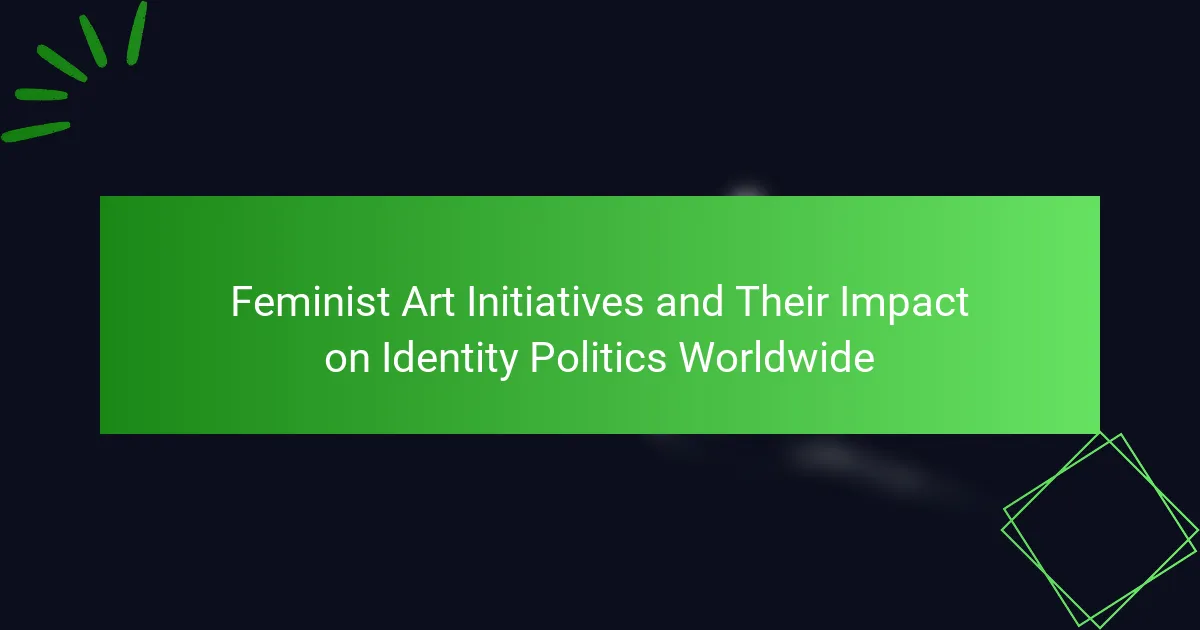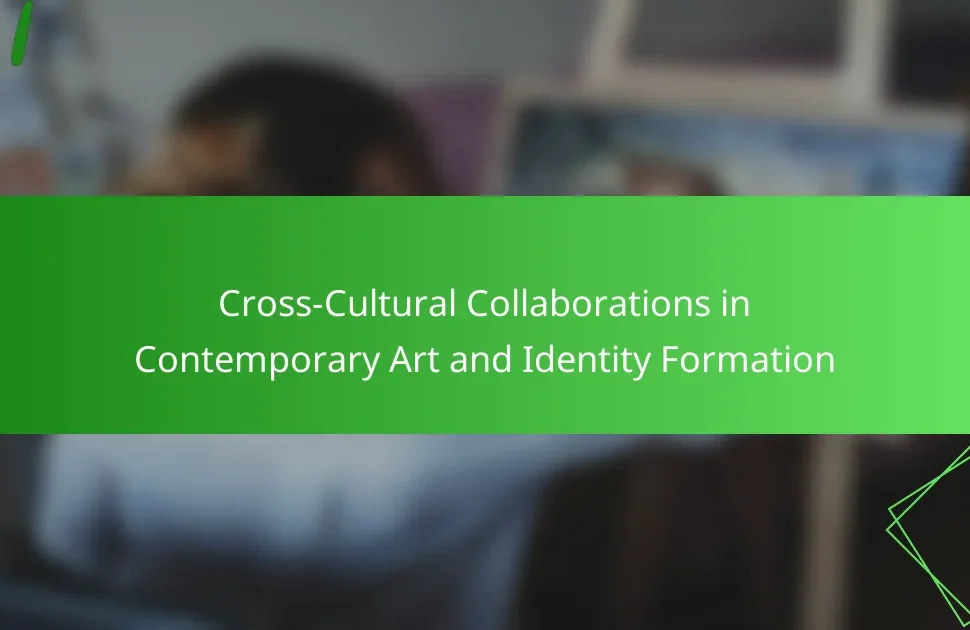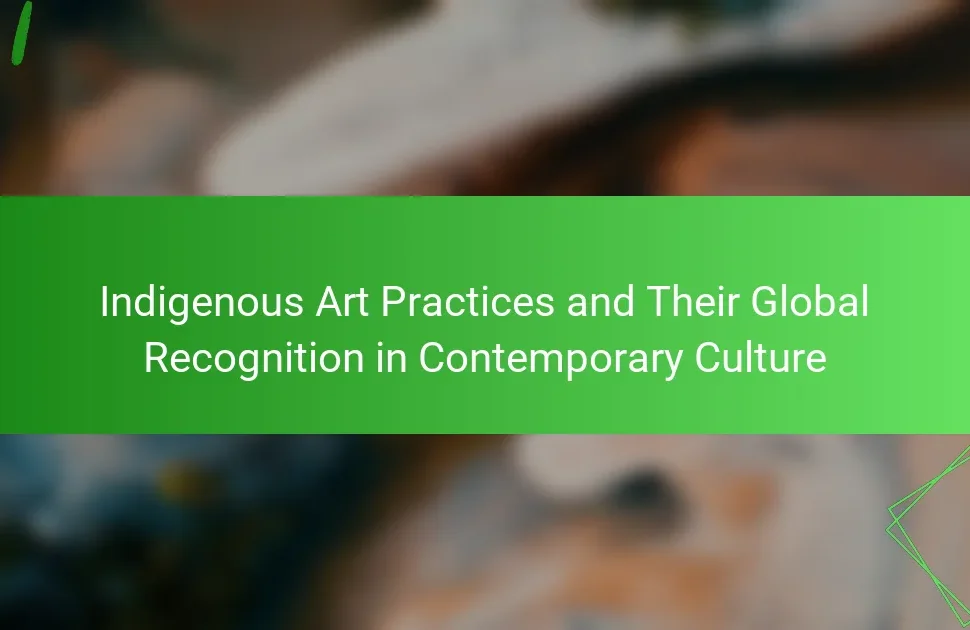Feminist art initiatives significantly impact identity politics by challenging traditional narratives and promoting diverse representations. They empower marginalized voices, foster inclusivity, and engage communities through public art. Notable projects like the Guerrilla Girls and the #MeToo Art Project highlight systemic inequalities and amplify crucial conversations. These initiatives also face challenges such as funding limitations and societal resistance, requiring strategic collaboration for sustained impact.
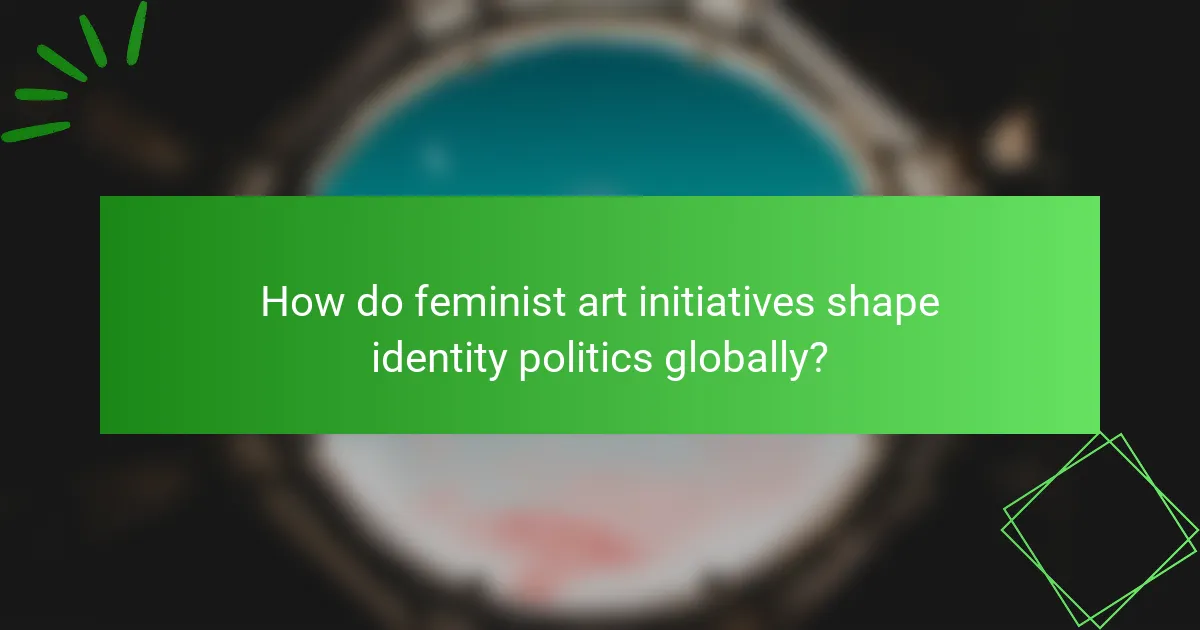
How do feminist art initiatives shape identity politics globally?
Feminist art initiatives significantly influence identity politics globally by challenging traditional narratives and promoting diverse representations. These initiatives empower marginalized voices, fostering inclusivity and dialogue around gender, race, and culture. They often utilize public spaces, making art accessible and engaging communities in critical conversations. For instance, projects like the Guerrilla Girls highlight systemic inequalities, encouraging activism and awareness. As a result, feminist art not only reshapes individual identities but also transforms societal perceptions, creating a more equitable cultural landscape.
What are the core principles of feminist art initiatives?
Feminist art initiatives prioritize inclusivity, challenge gender norms, and empower marginalized voices. They create spaces for dialogue and representation, fostering community and social change through artistic expression. These initiatives often emphasize intersectionality, addressing how race, class, and sexuality intersect with gender. By highlighting diverse experiences, they reshape identity politics on a global scale.
How do these initiatives influence societal perceptions of gender?
Feminist art initiatives significantly shape societal perceptions of gender by challenging traditional norms. They promote diverse representations of femininity and masculinity, fostering dialogue on identity politics. These initiatives often highlight unique attributes of gender experiences, encouraging inclusivity and awareness. As a result, they can shift public attitudes, leading to greater acceptance and understanding of gender diversity.
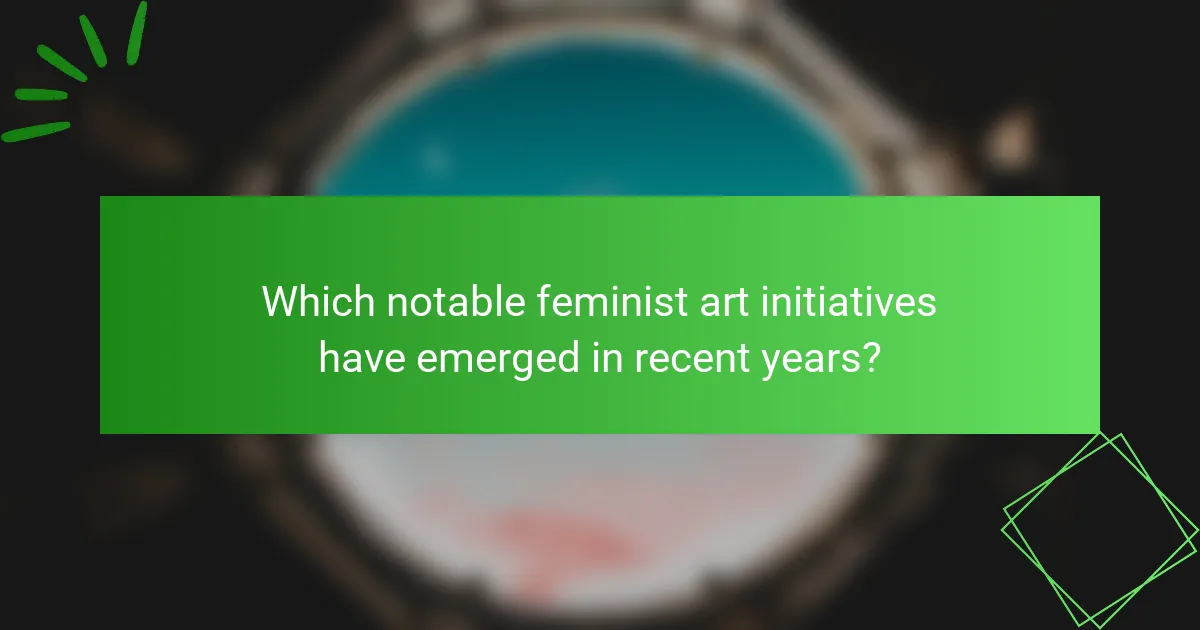
Which notable feminist art initiatives have emerged in recent years?
Notable feminist art initiatives in recent years include the Guerrilla Girls’ ongoing activism, the #MeToo Art Project, and the Feminist Art Coalition. These initiatives challenge traditional narratives and promote diverse voices in the art world. The Guerrilla Girls continue to raise awareness about gender inequality in the art industry through provocative posters and public interventions. The #MeToo Art Project amplifies stories of sexual harassment and assault through visual art, creating a platform for healing and dialogue. The Feminist Art Coalition unites institutions and artists to foster feminist perspectives and practices, impacting identity politics globally.
What impact did the Guerrilla Girls have on feminist art discourse?
The Guerrilla Girls significantly influenced feminist art discourse by challenging gender inequality in the art world. They used provocative visuals and humor to expose the underrepresentation of women and artists of color in galleries and museums. Their activism sparked discussions about identity politics and representation, reshaping the narrative around feminist art initiatives globally. By employing unique tactics, they created a lasting impact on how feminist art is perceived and discussed. Their work remains a critical reference point for contemporary feminist discourse in the arts.
How has the #MeToo movement influenced feminist art projects?
The #MeToo movement has significantly influenced feminist art projects by amplifying voices and experiences of marginalized individuals. This movement has led to a surge in artistic expressions that challenge societal norms and highlight issues of consent and gender-based violence.
Feminist art initiatives now often incorporate multimedia approaches to engage audiences emotionally and intellectually. Collaborations among artists from diverse backgrounds have become more common, fostering a sense of community and shared purpose.
Moreover, exhibitions and installations inspired by #MeToo have sparked conversations about identity politics and the representation of women in art. These projects not only reflect personal narratives but also serve as platforms for activism, advocating for systemic change within the art world and beyond.
As a result, feminist art continues to evolve, pushing boundaries and redefining the discourse around gender equality and social justice.
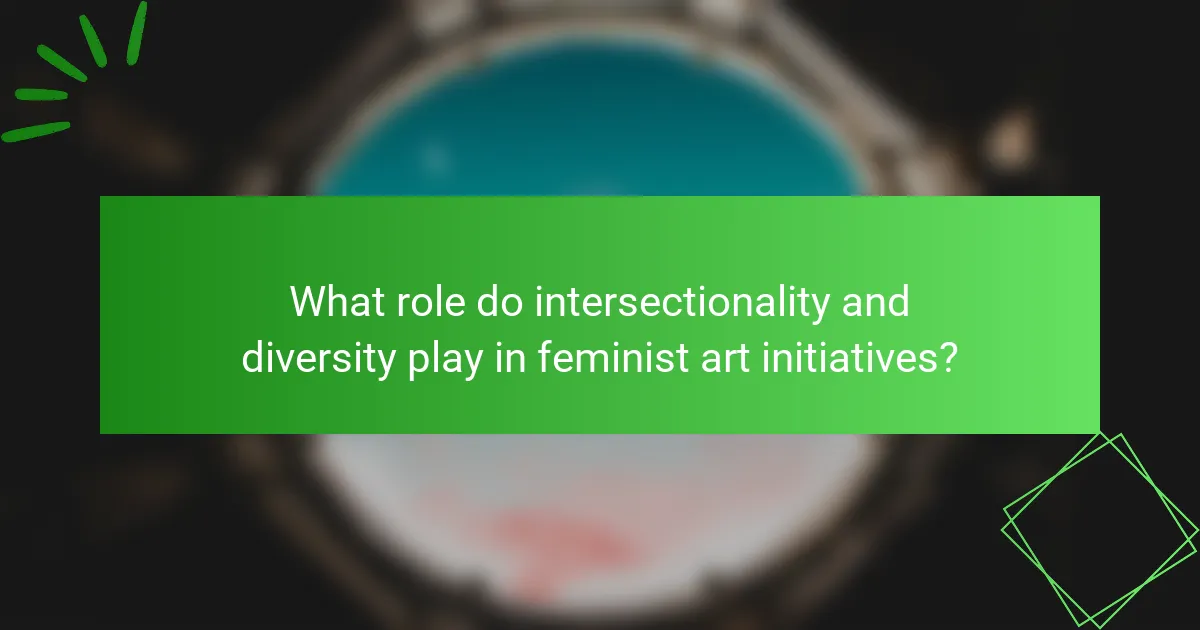
What role do intersectionality and diversity play in feminist art initiatives?
Intersectionality and diversity are essential in feminist art initiatives as they foster inclusive representation. These initiatives challenge dominant narratives by highlighting the experiences of marginalized groups. For instance, they often feature artists from various backgrounds, enriching the discourse around identity politics. This approach not only broadens the understanding of feminism but also amplifies voices that have historically been silenced. As a result, feminist art becomes a powerful tool for social change, promoting equity and understanding across different identities.
How do different cultural backgrounds inform feminist art practices?
Different cultural backgrounds significantly shape feminist art practices by influencing themes, styles, and narratives. Artists draw from their unique experiences and societal contexts, creating diverse expressions of feminism. For instance, Indigenous artists often incorporate traditional symbols, while urban artists might focus on contemporary social issues. This variety enriches global feminist discourse, highlighting intersectionality and identity politics. Cultural differences foster innovative approaches, allowing feminist art to resonate across various communities.
Which unique themes are explored by feminist artists in various regions?
Feminist artists explore themes of identity, empowerment, and social justice across various regions. In North America, themes often focus on intersectionality and representation. European artists frequently address gender roles and historical narratives. In Latin America, themes include cultural identity and resistance against patriarchy. Asian feminist art often critiques traditional norms and celebrates femininity. African artists highlight heritage and community struggles. These unique themes reflect diverse cultural contexts and social issues.
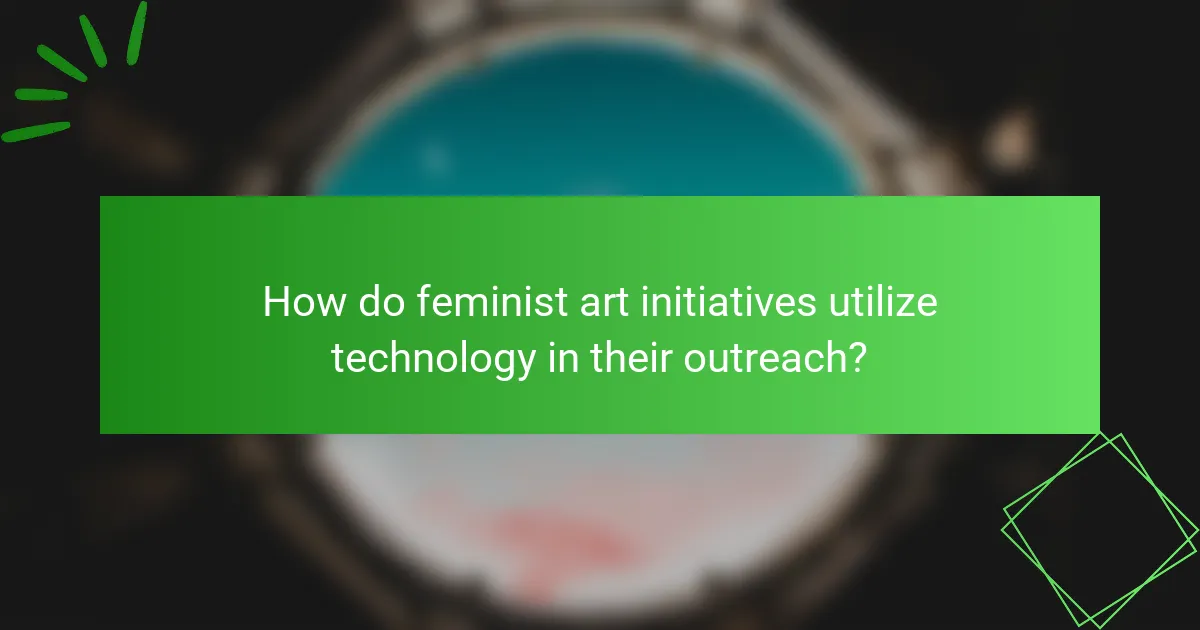
How do feminist art initiatives utilize technology in their outreach?
Feminist art initiatives effectively utilize technology to enhance their outreach and engagement. They leverage social media platforms to amplify voices and share diverse artistic expressions. Virtual exhibitions and online workshops expand accessibility, allowing global participation. Data-driven analytics help tailor content to specific audiences, increasing impact. Collaborative digital projects foster community and solidarity among artists and activists.
What digital platforms are most effective for feminist art initiatives?
Digital platforms like social media, online galleries, and crowdfunding sites are highly effective for feminist art initiatives. These platforms foster community engagement and amplify underrepresented voices. Social media, such as Instagram and Twitter, allows artists to share their work and connect with audiences globally. Online galleries provide accessible spaces for exhibitions, while crowdfunding platforms help secure financial support for projects. Together, they enhance visibility and impact in identity politics worldwide.
How does social media amplify the voices of feminist artists?
Social media amplifies the voices of feminist artists by providing platforms for visibility and engagement. These platforms facilitate direct interaction between artists and audiences, enabling the sharing of diverse narratives. Feminist art initiatives leverage social media to challenge traditional representations and advocate for identity politics. As a result, artists can reach global audiences, fostering solidarity and collaboration across movements.
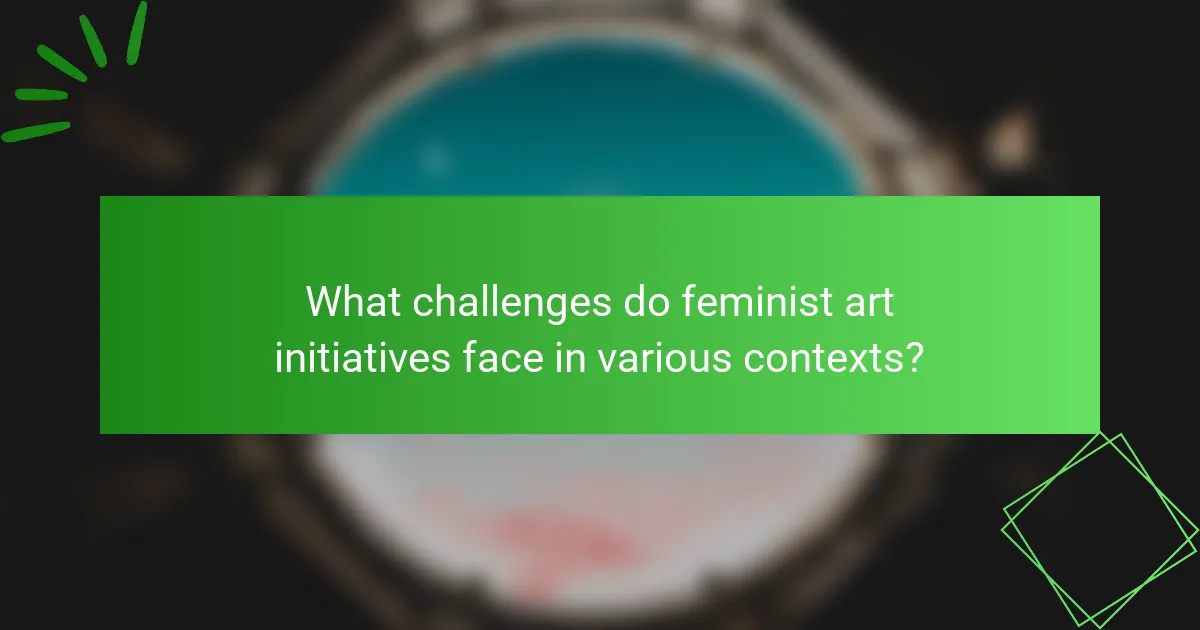
What challenges do feminist art initiatives face in various contexts?
Feminist art initiatives face challenges including funding limitations, societal resistance, and representation issues. These obstacles vary across cultural contexts, impacting their effectiveness and reach.
Funding is often scarce, limiting project scope and sustainability. Societal resistance can manifest through backlash against feminist themes, hindering public engagement. Additionally, representation challenges arise when initiatives fail to include diverse voices, weakening their impact on identity politics.
Global contexts further complicate these initiatives. In conservative regions, feminist art may provoke severe backlash, while in progressive areas, it might struggle for visibility among mainstream narratives.
Addressing these challenges requires strategic collaboration and advocacy to promote inclusivity and ensure sustained support for feminist art initiatives.
How do political climates affect feminist art initiatives worldwide?
Political climates significantly influence feminist art initiatives by shaping their themes, funding, and public reception. In repressive regimes, feminist artists often face censorship, limiting their expression. Conversely, supportive environments foster collaboration and visibility. For example, in countries with progressive policies, feminist art initiatives thrive, addressing identity politics openly. These initiatives can challenge societal norms and promote gender equality, reflecting the unique attributes of local cultures. Political support or opposition can determine the longevity and impact of these initiatives, making the political context a critical factor in their success.
What are common misconceptions about feminist art initiatives?
Common misconceptions about feminist art initiatives include the belief that they solely focus on women’s issues, overlook intersectionality, or lack artistic merit. These initiatives often address broader social justice themes and embrace diverse identities. Additionally, they challenge traditional art narratives and engage with various media, showcasing the complexity of identity politics globally.
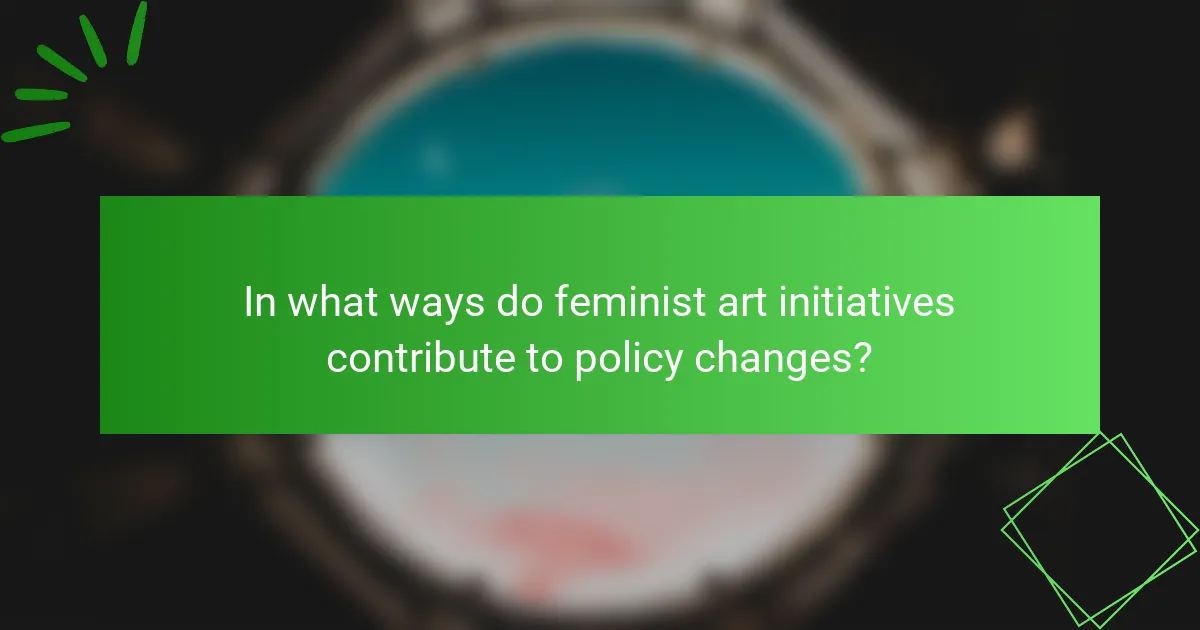
In what ways do feminist art initiatives contribute to policy changes?
Feminist art initiatives drive policy changes by raising awareness, influencing public discourse, and advocating for gender equity. These projects often highlight systemic inequalities, prompting legislative discussions and reforms. For instance, exhibitions can spotlight issues like reproductive rights, leading to policy advocacy. Additionally, collaborations with policymakers can result in tangible changes in laws and regulations that support women’s rights. The unique attribute of these initiatives is their ability to engage diverse audiences, fostering community dialogue and activism that extends beyond the art world.
How have feminist art initiatives influenced legislation related to gender equality?
Feminist art initiatives have significantly influenced legislation related to gender equality by raising awareness and advocating for policy changes. These initiatives often highlight social issues, mobilizing communities to demand legal reforms. For instance, projects like the Guerrilla Girls have challenged systemic inequalities, leading to increased representation in art institutions and legislative discussions. As a result, feminist art has become a catalyst for broader conversations on women’s rights, influencing laws that promote equality and protect against discrimination.
Which case studies exemplify successful advocacy through art?
Several case studies illustrate successful advocacy through art within feminist initiatives. The Guerrilla Girls effectively used posters and public performances to highlight gender inequality in the art world. Their work raises awareness and challenges the status quo. The “Women on Waves” project utilized art and activism to promote reproductive rights globally, showcasing how art can mobilize communities. Finally, the “The Dinner Party” by Judy Chicago serves as a powerful installation that honors women’s contributions to history, merging art with identity politics. These examples demonstrate the potent intersection of art and advocacy in feminist movements.

What are the future trends for feminist art initiatives?
Feminist art initiatives are increasingly focusing on intersectionality and global collaboration. These trends emphasize diverse voices and experiences, shaping identity politics worldwide. A rise in digital platforms is facilitating broader participation and visibility for underrepresented artists. Additionally, community-based projects are fostering local engagement and collective empowerment.
How might emerging technologies change the landscape of feminist art?
Emerging technologies will significantly transform feminist art by enhancing accessibility and expanding creative expression. Digital platforms enable artists to reach global audiences, fostering diverse perspectives in identity politics. Virtual reality and augmented reality create immersive experiences, allowing deeper engagement with feminist themes. Additionally, blockchain technology empowers artists by ensuring ownership and authenticity, promoting equitable representation in the art market. These advancements will redefine how feminist art is created, shared, and appreciated worldwide.
What strategies can feminist art initiatives adopt for sustainability?
Feminist art initiatives can adopt strategies like community engagement, collaboration, and education for sustainability. These approaches foster resilience and inclusivity within the art ecosystem.
Community engagement encourages local participation, enhancing relevance. Collaboration with diverse artists amplifies voices and resources. Educational programs raise awareness and build future audiences, ensuring ongoing support.
Additionally, leveraging digital platforms expands reach, allowing for global participation. Sustainable funding models, such as grants or partnerships, can provide financial stability.
By integrating these strategies, feminist art initiatives can thrive and continue to impact identity politics worldwide.
What best practices can enhance the effectiveness of feminist art initiatives?
Feminist art initiatives can enhance effectiveness by fostering community engagement, promoting diverse voices, and utilizing digital platforms. Community involvement ensures relevance and connection, while diverse representation broadens perspectives. Digital platforms expand reach and accessibility, enabling global dialogue. These practices collectively strengthen identity politics through art.
